Tiverton has some extraordinary people buried in her historical cemeteries around Town. Here are six of them…
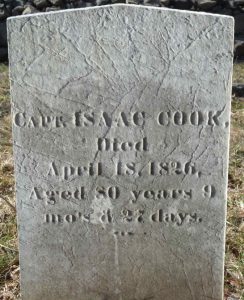 Captain Isaac Cook
Captain Isaac Cook
Revolutionary War
Isaac Cook was Captain of the 1st Company Tiverton Militia in the American Revolution from 1776 to 1779, during the British occupation of Aquidneck Island, the Battle of Freetown, the Siege of Rhode Island, and the Battle of Rhode Island. There were two companies of Rhode Island militia in Tiverton during the War.
Isaac was born on June 21, 1745 in Tiverton to Thomas Cook and Philadelphia Cornell. He married Lydia Gray, the sister of Captain Robert Gray, who also served in the Revolution as a privateer under General Washington. They had ten children: William, Reuben, Elizabeth, Charlotte Cook Almy, Sarah, Hannah, John, Dennis, Isaac, and Godfrey.
His two sons, William and Godfrey, inherited parcels of Isaac’s farm, located on both sides of Main Road near the south end of Nonquit Pond. Godfrey had the lot to the south of the stone wall and William had the adjacent farm to the north.
Isaac and Godfrey are buried in Cemetery #30 and William in #31, on the north side of the stone wall that bounds the two properties on the east side of Main Road.
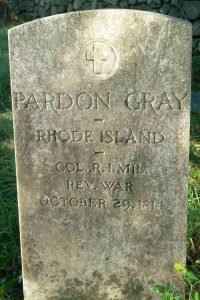 Colonel Pardon Gray
Colonel Pardon Gray
Revolutionary War
Pardon Gray is listed as Major of the 2nd Regiment of Militia in Newport County in 1776 and 1777. He is also listed as an assistant to Rhode Island Governor Nicholas Cooke in 1777, and a member of the State Council of War in 1779.
Gray was promoted to Lieutenant Colonel and put in charge of the Commissary for the 10-15,000 Troops stationed at Tiverton from 1777 to 1778 during the Battle of Rhode Island, converting his residence into the Commissary Headquarters. All the bread was baked in the large stone ovens in his house by his wife. He was a personal friend of the Marquis de Lafayette who visited him in Tiverton during the Revolutionary War.
After the War, Gray was appointed Justice of the Rhode Island Superior Court in 1784 and 1785.
Pardon was born on April 20, 1737 in Tiverton to Philip Gray and Sarah Cory. His brother was Philip Gray, who also served in the Revolution as a privateer. He married Mary Brown of Little Compton in 1755. They had twelve children: Job, Sarah, Edward, Mary, Lydia Gray Almy, Abigail, Philip, Pardon, Hannah Cook, John, Thomas, and Mary Seabury.
He died on November 28, 1814 and is interred in the family burial ground in back of where his farmhouse used to be on what is now Pardon Gray Preserve.
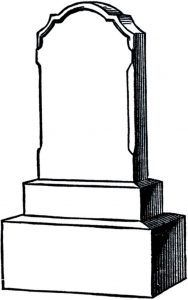 General Benjamin Howland
General Benjamin Howland
War of 1812
General Howland was born in Tiverton on July 27, 1755 to Wanton and Ruth Brown Howland of Little Compton. After his father’s death, his mother married Judge Gilbert Devol and had the first of nine children in 1766.
First engaged in farming, Howland’s career in public affairs began in 1801 as Collector of Taxes in Tiverton. In 1802, he became Town Auditor, and three years later, the Town Moderator.
Howland was elected to the United States Senate in 1804 as a Democratic Republican to fill the vacancy caused by the death of Samuel J. Potter, winning by two votes. He served until 1809, and was subsequently elected a member of Rhode Island’s State Legislature in 1810.
He served as a general in the Rhode Island State Militia during the War of 1812.
Benjamin married Mary and had a daughter, Ruth, in 1795. Unfortunately, Ruth died when she was 8 years old.
General Howland died in Tiverton on May 1, 1821 and was buried in the family plot with his daughter on his estate near Bridgeport. Later records state he was moved to Pocasset Cemetery, however, there is no record of him being reinterred there in the Pocasset Cemetery records. His gravestone is also missing.
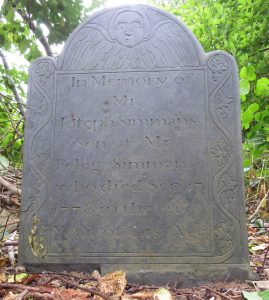 Joseph Simmons
Joseph Simmons
Revolutionary War
Joseph Simmons was the son of Tiverton’s Captain Peleg Simmons and Mary Brownell of Little Compton, born on November 7, 1757. He served in his father’s Company as a junior officer and was present during the British raids on the mainland, Spencer’s Expedition, and the Battle of Rhode Island at the time when British forces occupied Aquidneck Island (a.k.a. Rhode Island).
On September 17, 1778, just after the Battle of Rhode Island, Joseph died. He is buried in the family burial ground at what is now known as Wingover Farm.
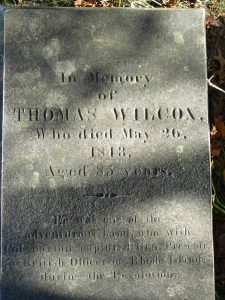 Thomas Wilcox
Thomas Wilcox
Revolutionary War
Thomas Wilcox enlisted as a Private in Captain William Cook’s Company of Colonel Church’s Regiment in 1775. The next year, he was under Captain John Carr’s Company in Colonel Lippitt’s Regiment.
In 1777, Carr’s Company was assigned to Lt. Colonel William Barton’s Regiment, and Wilcox was one of the forty men who participated in the capture of British General Prescott on Rhode Island, trading him for the American General Sullivan, taken prisoner by the British.
Wilcox is listed in Captain Ebenezer Adams’s Company of Colonel Elliott’s Regiment in 1778, and ended his service under Captain Peleg Simmons’ Company in 1779.
Thomas Wilcox was born in Tiverton on August 28, 1757 to William and Elizabeth ‘Betsy’ Horswell Wilcox. He married Keziah Bennett on June 8, 1782 with Walter Cook, Justice of the Peace, presiding. They had 11 children.
Thomas died on May 26, 1843. His gravestone documents his heroic effort in 1778: “He was one of the adventurous band who with Col. Barton captured Gen. Prescott a British officer in Rhode Island during the Revolution.”
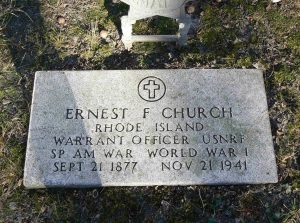 Ernest Fisher Church
Ernest Fisher Church
Spanish-American War
World War I
Ernest Fisher Church was born on September 21, 1877 to Captain Fisher and Letty Bell Ray Church. Captain Fisher Church was one of the famous Seven Church Brothers who ran the fishing industry in Tiverton with their father, Joseph. He married Hazel May Cobb of Connecticut and had two daughters.
He enlisted in the United States Navy as an Apprentice, First Class on board the USS Olympia, the flagship of Commodore Dewey. On May 1, 1898, The USS Olympia led the Squadron in line of battle against the Spanish Fleet, opening the battle by saying “You may fire when ready, Gridley.” When the smoke had cleared, the Spanish fleet had suffered a terrible loss in ships and men, whereas Dewey’s squadron had only a few men wounded. After the battle, the USS OLYMPIA took part in the blockade and capture of Manila itself. On May 20, 1899 she pointed her bow back toward China, and then for Boston, passing through the Suez Canal.
When he came home to Tiverton, he captained one of the Church fishing steamers once more. Ernest’s Naval career started again when he enlisted in March of 1917 at the 3rd Naval District. He also served as a Marine Pilot. He was discharged in 1919.
Church died on November 21, 1941, and is buried in the Captain Joseph Church plot, Historical Cemetery #44.
Remember these brave veterans of Tiverton – and thank a veteran this November!
[Histories and Gravestones from the Tiverton Historical Preservation Advisory Board/Tiverton Historical Cemeteries Commission exhibited at the Town Hall in May of 2019; currently in the flat files in the History Room of the Tiverton Public Library]
